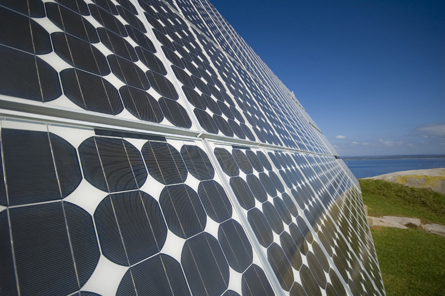Module 6
1. Module 6
1.7. Lesson 2
Module 6—Wave-Particle Duality and Quantum Physics
Lesson 2—The Photoelectric Effect

© Adrian Matthiassen/shutterstock
 Get Focused
Get Focused
Solar panels are designed to convert the energy of electromagnetic radiation into useable electrical current. From powering hand-held calculators to charging batteries and providing household electricity, the solar cell is a carbon dioxide-free, renewable energy resource. It is also an excellent example of how photons interact with metal surfaces in a process that sheds light on the quantum nature of electromagnetic radiation.
Solar cells are just one variation of many applications that harness the photoelectric effect, a phenomenon in which electrons are emitted from a metal surface after absorbing energy from electromagnetic radiation. In this lesson you will explore the photoelectric effect and its relationship to quantum theory.
The evolution of both photoelectric technology and quantum theory occurred simultaneously. The first crude solar cells were developed at the turn of the 19th century after the interaction between radiation and metal surfaces was observed by Heinrich Hertz in his classic experiment to produce and detect EMR. In 1905 Einstein explained this effect using quantum theory and was awarded the Nobel Prize for it in 1921. By that time, quantum theory had become mainstream in scientific circles. In 1954 Bell Laboratories accidentally discovered that silicon, when mixed with certain metal impurities, was very sensitive to light. Four years later, in 1958, both Russian and American satellites deployed solar cell technology to power their satellites. Today, thanks to applications in space exploration and research and an understanding of quantum theory, photoelectric technology is deployed in countless applications, from automatic door openers, to remote pumping stations in northern Alberta, and even to the battery chargers that power the Spirit and Opportunity rovers on Mars.
In this lesson you will answer the following essential questions:
- What is the photoelectric effect?
- How is the photoelectric effect described by quantum theory?
- How does the photoelectric effect support the notion of wave-particle duality?
 Module 6: Lesson 2 Assignment
Module 6: Lesson 2 Assignment
Your teacher-marked Module 6: Lesson 2 Assignment requires you to submit responses to the following:
- Assignment—A 1, A 2, A 3, A 4, A 5, A 6, A 7, A 8, A 9, and A 10
- Discuss—D 2
The other questions in this lesson are not marked by the teacher; however, you should still answer these questions. The Self-Check and Try This questions are placed in this lesson to help you review important information and build key concepts that may be applied in future lessons.
After a discussion with your teacher, you must decide what to do with the questions that are not part of your assignment. For example, you may decide to submit to your teacher the responses to Try This questions that are not marked. You should record the answers to all the questions in this lesson and place those answers in your course folder.